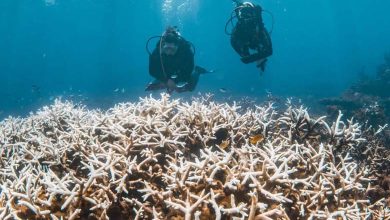Environmental Shift: Sharks Enter the Shallow Waters of the Eastern Mediterranean

In a recent report, the Israeli newspaper Yedioth Ahronoth highlighted a puzzling environmental phenomenon that has caught the attention of both the public and authorities. It was revealed that large numbers of sharks have been gathering in the shallow waters off the coasts of three Israeli cities: Hadera, Ashkelon, and Ashdod. This unusual occurrence has raised several questions, as authorities have not yet provided a clear explanation for the reasons behind this behavior. The presence of the sharks in such close proximity to coastal areas has led to concerns, especially given the frequency with which they are appearing.
-
Massive Sharks Eating Each Other Uncovered
-
It Don’t Live in the River… Dead Sharks Terrify Residents of an American State
What stands out about these gatherings of sharks is their specific location—near Israeli power plants, particularly the Orot Rabin power plant in Hadera. This proximity to power plants has sparked the hypothesis that the warm water discharges from these facilities might be attracting the sharks. The idea that sharks are drawn to these warm waters is not new, and various experts are considering this as a potential explanation for the behavior of the sharks in these specific areas. However, despite this theory, the phenomenon remains somewhat of a mystery.
These shark gatherings, which have raised concerns among the public and government, have been observed near Israeli power plants, particularly the Orot Rabin plant in Hadera. This phenomenon is suspected to be linked to the warm water discharges from these facilities.
-
Extreme Heat Devastates Coral Reefs in Western Australia
-
600-year-old coral reefs reveal climate secrets
The phenomenon of sharks gathering in these waters has stirred a mix of concern and curiosity among the public and local government officials. The sharks have been spotted frequently near Israeli power plants, which has led many to speculate about the cause of their presence. The Orot Rabin power plant in Hadera, one of the most significant sources of concern, has become the focal point of these discussions. As the plant uses seawater to cool its turbines, it releases warm water back into the sea. This warm water, which is significantly hotter than the surrounding waters, could potentially be creating a unique environment that attracts sharks. The water from these power plants is said to be approximately 10 degrees Celsius warmer than the surrounding sea, which could be contributing to the unusual gathering of sharks in these areas.
This phenomenon has led researchers and environmental experts to question the extent of human impact on marine life. While the presence of sharks near power plants is not entirely unprecedented, the concentration of sharks in certain locations, such as near the warm water discharge points, could represent a shift in their behavior. This has prompted further investigation into whether such environmental changes might be influencing marine species in new and unforeseen ways.
-
Florida: The Shark Attack Capital of the World
-
Mass stranding of dozens of pilot whales on the shores of Australia
According to the report, a widely accepted hypothesis suggests that the heated water from power plants attracts the sharks.
A widely accepted hypothesis, mentioned in the report, suggests that the warm water discharged from power plants is indeed a key factor in attracting sharks to these areas. As the power plants release heated seawater, they create an environment that is particularly appealing to certain marine species, including sharks. This phenomenon is not entirely unusual, as warm waters are known to attract various forms of marine life, including fish and other predators. The warm water serves as an inviting habitat for fish, which in turn attract predators such as sharks looking for food. Given the large amount of heated water discharged by power plants, it creates a strong current in the surrounding waters, extending up to two kilometers from the outlet. This could explain why sharks are consistently drawn to these specific areas.
-
Shark Attack Terrifies New York… Woman in “Critical Condition”
-
An “Environmental Disaster” Threatens Tripoli, Lebanon
In addition to the warmth of the water, the presence of fish species that are typically attracted to the heated areas provides a steady food source for the sharks. This creates a sort of feeding ground that makes it an ideal location for the sharks to gather. Such a natural phenomenon, while fascinating, warrants closer study from marine environmental researchers to understand the broader implications it may have on the local ecosystem and marine life.
The newspaper attempts to reassure the public, stating that swimming near these sharks is not necessarily dangerous, as they frequently inhabit Israeli coastal waters.
-
“Environmental Disaster”: Dam Collapse Claims the Lives of Dozens of Yemenis
-
Environmental Concern… Can Climate Change Make You Depressed?
While the gathering of sharks has understandably raised concerns among the public, Yedioth Ahronoth has made an effort to reassure citizens that the sharks in question are not necessarily a threat to humans. The report emphasizes that swimming near these sharks is not inherently dangerous, as sharks frequently inhabit Israeli coastal waters. In fact, it is common for certain shark species to be found along the Mediterranean coast. The presence of sharks in these areas is not entirely out of the ordinary, and they are often seen in these waters, especially in regions with warmer temperatures.
The newspaper’s reassurance aims to alleviate fears and help the public better understand the nature of this phenomenon. It is important to note that while the presence of sharks near popular beaches might seem alarming, they typically do not pose a significant danger to swimmers. Sharks generally avoid human contact unless provoked, and their primary focus is often on their natural food sources rather than engaging with humans.
-
After the discoloration of the waters in Venice… What are the “guidelines” for environmental protest?
-
Extreme Heat Devastates Coral Reefs in Western Australia
A Natural Phenomenon or Human Impact?
The question of whether this shark gathering is a natural phenomenon or the result of human impact is one that continues to be debated. On one hand, it could be seen as a natural occurrence, with sharks simply following their instincts and moving toward areas with abundant food sources. On the other hand, the fact that these gatherings are occurring specifically near power plants and other human-made structures suggests that human activity may be influencing the behavior of marine life.
Reports indicate that between 40 and 80 sharks have been observed gathering in the shallow waters near Orot Rabin from November to May, which aligns with the period when the warm water discharges are most prominent. The Orot Rabin power plant, located at the mouth of the Hadera River, uses seawater to cool its turbines. This discharge of warm water back into the sea could be influencing the sharks’ migration patterns. As the temperature difference between the surrounding waters and the discharged water is significant, it creates a natural draw for sharks in the area.
-
Study: The World Turns Off Its Lights Tonight… Earth Hour Rings the Climate Alarm
-
Scientists Turn Animal Feces into a Reproductive Tool to Save Rare Species
Reports indicate that between 40 and 80 sharks gather in the shallow waters near Orot Rabin from November to May. This power plant, located at the mouth of the Hadera River, uses seawater to cool its turbines.
According to reports, it has been noted that between 40 and 80 sharks gather in the shallow waters near the Orot Rabin power plant between November and May. This period coincides with the time when the power plant releases the warm water back into the sea, which seems to attract a variety of marine species, including sharks. The Orot Rabin plant is located at the mouth of the Hadera River, and it is known for using seawater as part of its cooling process for turbines. The warm water released from the plant creates an area of higher temperature that is enticing for marine life, including fish, which in turn attract the sharks.
The warm water discharged by the plant is estimated to be about 10 degrees Celsius warmer than the surrounding waters. This temperature difference creates a noticeable current that extends as far as two kilometers from the outlet. This warm-water current is an important factor in the gathering of sharks, as it likely provides both a comfortable environment and a reliable food source for these marine creatures. The sharks’ presence in these waters has sparked interest in how human activity, such as the operation of power plants, may be influencing the behavior of local wildlife.
-
Danger Looms from the Oceans… The UN Issues a Stark Warning to Humanity
-
Shocking Report: 14 Indian Cities Among the Most Polluted in the World
This warm water also attracts other fish species, which serve as a food source for the sharks, making this an unusual occurrence worthy of study by marine environmental researchers.
The warm water discharged by the power plants also has the effect of attracting other fish species that thrive in higher temperatures. These fish, in turn, become an important food source for the sharks, which may explain why such gatherings occur in these areas. The presence of both warm water and abundant food creates an ideal environment for sharks to congregate. This phenomenon is not only of interest to the public but also to marine environmental researchers, who are eager to study the long-term effects of such gatherings on local ecosystems.
The relationship between warm water discharges from power plants and the attraction of marine life is a subject of growing interest in marine biology. Understanding how human-made structures impact the behavior of marine species is crucial for managing and protecting marine ecosystems. Researchers are particularly interested in how these changes might affect not only sharks but also other marine life that depends on specific environmental conditions to survive.
-
A Unique Observation: Optical Fibers Capture the Return of a Space Capsule to Earth
-
Libya: Moving Sea Turtle Nests to Protect Them from Extinction
While the Red Sea has a greater diversity and movement of shark species than the Mediterranean, several incidents have been recorded in recent years due to this trend.
The Mediterranean Sea, while home to several species of sharks, has historically seen less diversity and movement of shark species compared to the Red Sea. However, in recent years, there have been increasing reports of shark sightings in Mediterranean waters, particularly in regions like Israel. The presence of sharks near coastal areas and power plants could be indicative of a shift in shark behavior and movement patterns in the Mediterranean.
Although the Mediterranean is not as rich in shark diversity as the Red Sea, the phenomenon of sharks gathering near power plants is becoming more common. This trend is a result of environmental changes, both natural and human-induced, that may be altering the conditions of marine ecosystems. Researchers have noted an increase in shark sightings and incidents in the Mediterranean in recent years, suggesting that this pattern could continue as environmental factors evolve.
-
A decades-long journey… A massive iceberg settles near a remote island
-
Birds Facing Climate Change: Diverse Strategies for Survival
Sharks Pose No Threat to Humans
To address public concerns about the safety of swimming near sharks, Yedioth Ahronoth reassured readers that the sharks observed in the shallow waters of Hadera, Ashkelon, and Ashdod do not pose a significant threat to humans. The primary species identified in these areas include large pregnant female sandbar sharks and male white sharks. These species are generally not aggressive toward humans, and encounters between sharks and swimmers are rare.
The reassurance from the newspaper aims to calm public fears, emphasizing that while sharks may appear intimidating, they are not actively seeking out human interaction. The sharks observed in these coastal areas are more likely to be focused on their natural food sources rather than on human swimmers. As always, it is advisable for swimmers to exercise caution and avoid areas where sharks have been sighted, but the presence of sharks in these waters should not be cause for panic.
-
Gen Z’s Climate Anxiety: Thoughts on Future Disasters
-
Scientists Warn That the World Has Entered a “New Climate Era”… What Is the Cause?
In conclusion, Israeli media emphasize that this phenomenon does not constitute a threat but rather a marine environmental transformation that should not cause alarm.
In conclusion, Israeli media outlets have sought to downplay the potential risks associated with this unusual shark gathering. They emphasize that this is not a sign of danger but rather a natural marine environmental transformation, which should not cause undue alarm. The phenomenon, while interesting and unusual, does not pose a direct threat to human safety. Instead, it highlights the ways in which human activities, such as the operation of power plants, can inadvertently affect marine ecosystems and the behavior of marine life. As researchers continue to study this phenomenon, it will be important to monitor how such environmental changes impact both the sharks and the surrounding marine life.












